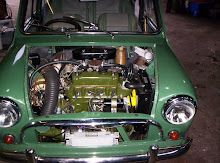One of the most common causes of the piston sticking is incorrect centring of the jet in relation to the needle. A large proportion of the carburettors returned to the S.U. works as defective are found on examination to be suffering from nothing more serious than this fault, which is easily rectified.
When the piston is at its lowest point and the jet is in its normal running position, only a very small radial clearance exists between the tapered needle and the opening in the jet. Provision is made in the jet assembly, therefore, for a limited amount of radial movement in order to allow it to be aligned with the needle, when it can be locked in position by means of a screwed sleeve (17, in Fig. 29), the hexagonal head of which can be seen at the base of the jet housing, above the spring that locks the jet adjusting nut.
Disconnect the mixture control and the fast-idle interconnecting link from the base of the jet and unscrew the union that connects the nylon feed tube to the float chamber. The jet can then be withdrawn, complete with the tube. Next remove the jet-adjusting nut and its locking spring and replace the jet, which can now be raised to a higher point than normal. Slacken off the sleeve that locks the jet bearing until it is just possible to rotate the bearing with the fingers.
Remove the piston damper and with a pencil apply gentle pressure to the end of the piston rod so that the needle will centralize the jet; while doing this, make sure that the feed tube is pointing in the correct direction, towards the union on the float chamber. The jet bearing should then be tightened. Still holding the jet up as far as possible, raise the piston and check that it falls freely. If it sticks, or if it strikes the jet bridge with a sharp click only when the jet is lowered, the centring process must be repeated.
Thursday, 15 October 2009
Centralizing the Jet
Posted by Info Mini Cars at 04:20
Subscribe to:
Post Comments (Atom)


0 comments:
Post a Comment